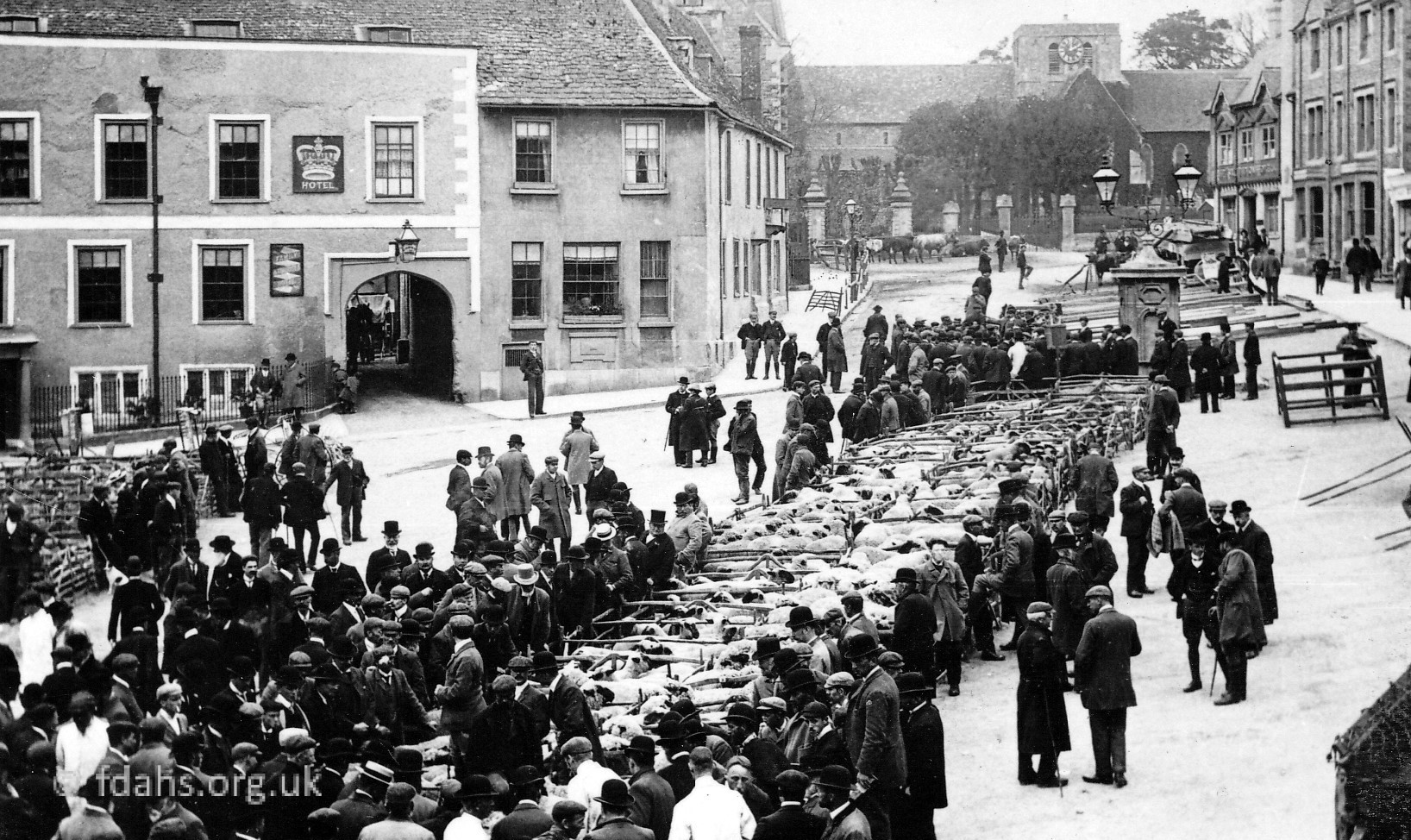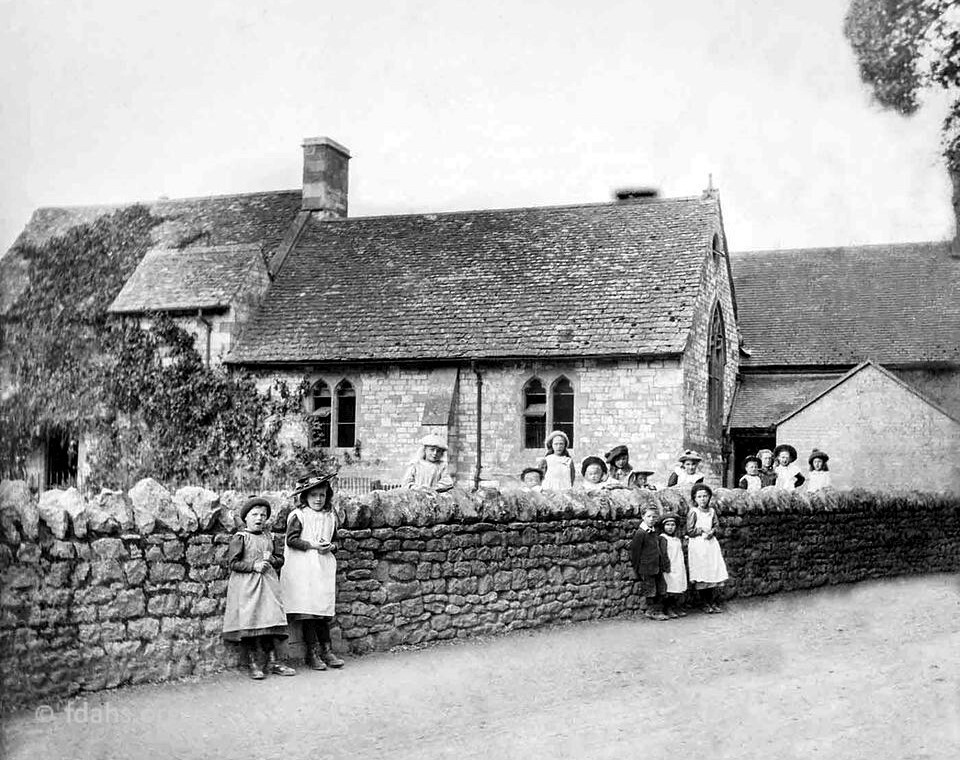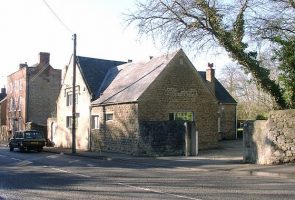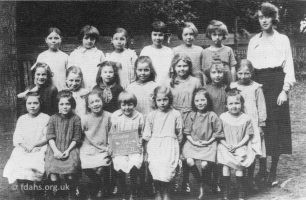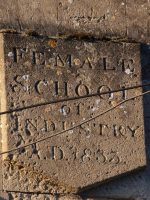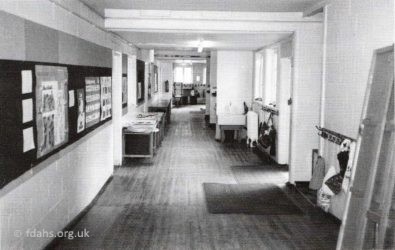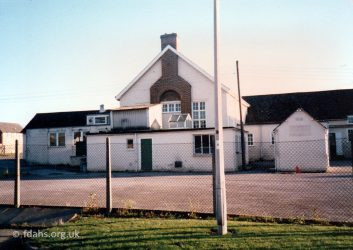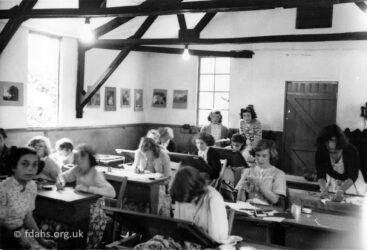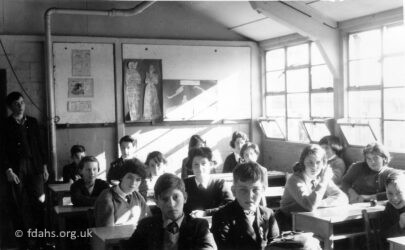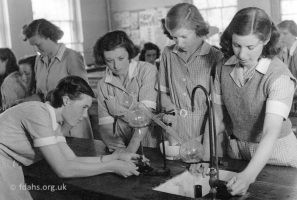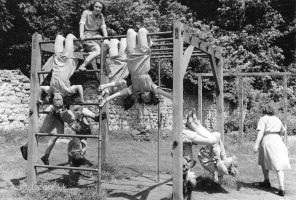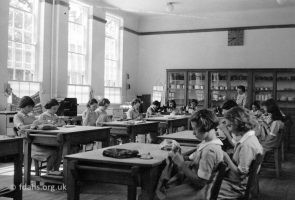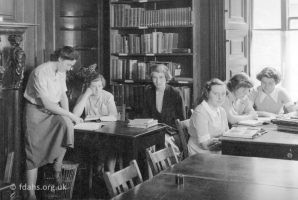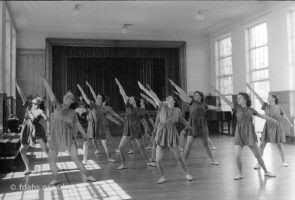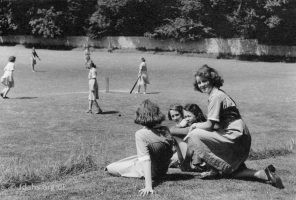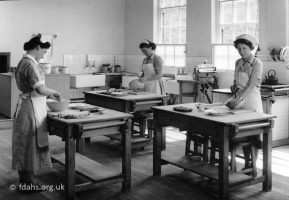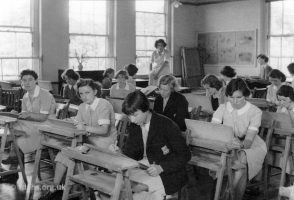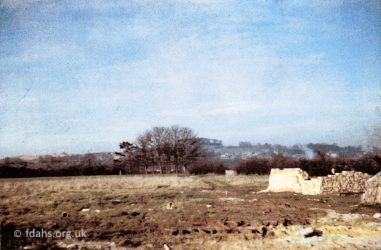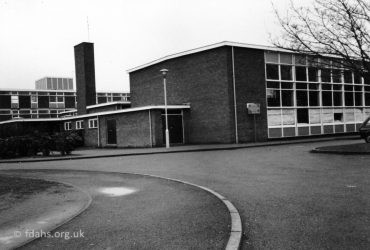The schools in Faringdon have a complex history as they moved about and changed name quite frequently during the 20th Century. It might therefore be easier to follow their history if they are categorised in most cases according to the road on which the buildings were located rather than by the name of the school; and start with the earliest established.
Fee-paying private education had been available for many centuries but free elementary education for the poor wasn’t established in England until the early 19th century when every parish was required to provide it. However, attendance was not compulsory and children were often made to work on the land or in factories instead. Funding was sparse – raised from various charities and churches. The curriculum was very basic and majored on religious education. In 1880, school attendance was made compulsory for children up to the age of 10, increasing to age 12 in 1899. The 1902 Education Act established Local Education Authorities (LEAs) with the ability to raise local taxes and instigated the separation of schools into primary and secondary. One historical consequence of this was that the common masses were now able to read and write, a privilege previously confined to the more wealthy. So for the first time most soldiers were able to write letters home from the battle field during World War I.
In September 1919 all persons over 12 years of age and not at school were offered continuation classes in the Faringdon Council Schools for a fee of one shilling (5p) for 2 terms but free if they had just left school. In 1921 compulsory education from 5–14 years came into effect. The minimum leaving age was raised to 15 in 1944, 16 in 1973, and 18 in 2015.
Sudbury House (London Road)
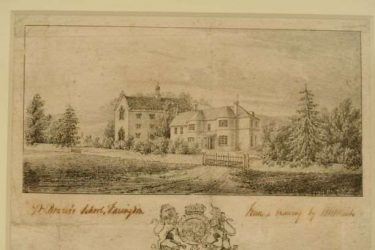
1777-1839. A private day and boarding school existed on the site of Sadbury House (as it was then known) from at least 1777 until it closed finally around 1839. The school was first advertised in 1777 by Rev. John Bradley, who was also Vicar of All Saints Church. The school catered for young gentlemen from the up and coming middle classes for a fee of £16 a year. Places would probably have been offered to boys anywhere between 7-16 years of age. At that time it would basically have been a seminary, a school of theology but it also included dancing, writing and arithmetic. Rev Bradley died in 1794 and what happened in the following 30 years has not been discovered.
In 1824 Dr Joseph Bowles purchased the estate and took over the running of the school, which he referred to as an English, French, Classical, Commercial and Mathematical Academy and gave it the name of ‘Faringdon Hall’. The fees ranged from £20 to £105 depending on the family wealth and status. A report in the Oxford Journal in 1825 stated that a school room was being built, 60 feet by 20, and of proportional height, with library, and cold baths. This was presumably a reference to the building or perhaps just a room improvement of the medieval-styled hall shown behind the house to the left in the drawing. The school has been identified by the handwriting on this drawing as ‘Dr Bordes’s School’ (so perhaps it became known by the name of the previous owner before Dr Bowles took it over). Dr Bowles left the house and the school in 1839 and the school building was completely demolished sometime after 1850.
Union (Ferndale) Street
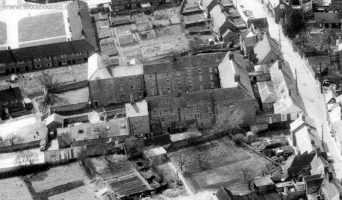 1801-1933 The Poor Law Union Workhouse School. For children of the adults living in the workhouse. The children were cared for by a Foster Mother and Father and were only allowed to see their parents on a Sunday at the compulsory Chapel services and in the afternoon in the dining room. Elementary education had to be provided on the premises and they had to learn reading, writing and arithmetic. There were two separate units, one for boys and one for girls. In the later years the children attended local schools. More…
1801-1933 The Poor Law Union Workhouse School. For children of the adults living in the workhouse. The children were cared for by a Foster Mother and Father and were only allowed to see their parents on a Sunday at the compulsory Chapel services and in the afternoon in the dining room. Elementary education had to be provided on the premises and they had to learn reading, writing and arithmetic. There were two separate units, one for boys and one for girls. In the later years the children attended local schools. More…
Stanford Road
1826-1936. The National School for Boys, 120 boys, age 6+. National Schools were charitable schools affiliated to the Church of England, which were established in every English and Welsh parish. It later became Faringdon Church of England Boys School, age 11-14 boys, then closed in 1936. The building, which is on the far corner with Berners Way, and shown here derelict and up for sale has now been renovated into two private houses.
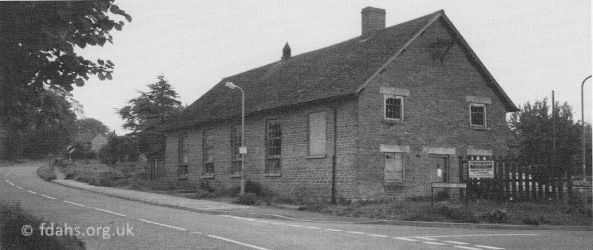 The National School was opened in 1826 in a building in Stanford Road to take about 120 boys. The rules of the school were that children of the poor attaining the age of 6 years and upwards should be allowed to benefit by education and that they should pay 7d per week. They would be taught spelling, reading and the general principles of the Christian religion. Those children who behaved well and showed aptitude would also be taught writing and arithmetic. Stealing, lying, swearing, indecent behaviour and conversation was strictly forbidden. It was required that pupils should have clean hands and faces and their hair cut short. By 1873 the subjects being taught were, Geography, Physiology, Grammar, Table Writing, Numeration, Reading, Religious Instruction, Arithmetic, Science, Dictation, History and Poetry. In 1875 there was a severe outbreak of scarlet fever and many children were not allowed to come to school if the disease was present in their family.
The National School was opened in 1826 in a building in Stanford Road to take about 120 boys. The rules of the school were that children of the poor attaining the age of 6 years and upwards should be allowed to benefit by education and that they should pay 7d per week. They would be taught spelling, reading and the general principles of the Christian religion. Those children who behaved well and showed aptitude would also be taught writing and arithmetic. Stealing, lying, swearing, indecent behaviour and conversation was strictly forbidden. It was required that pupils should have clean hands and faces and their hair cut short. By 1873 the subjects being taught were, Geography, Physiology, Grammar, Table Writing, Numeration, Reading, Religious Instruction, Arithmetic, Science, Dictation, History and Poetry. In 1875 there was a severe outbreak of scarlet fever and many children were not allowed to come to school if the disease was present in their family.
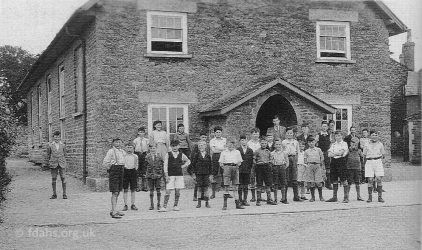 Punishments were severe e.g. 1882: “Jesse Jackson, 10 years old, caned for swearing in the street; Joseph Pauling caned for writing filthy words on his slate during lessons, 6 strokes across the desk.”; 1898: “Dear Sir I have sent the boys to the British School but it was not because you caned him for swearing but you beating him about the head, I hear you beat him for every other boy. Yours truly Mrs Perry.” Sometimes the notes from parents told a pathetic story – 1890: “Please Mr Shirley I must ask you not to overwork Charlie for a time as during the holidays he broke a blood vessel in his head and laid at the point of death for 2 days. The doctor said his head is a long way from right. Mrs Yates. (son Charles aged 7 years).”; 1893: “Dear Sir. Could you let Frank come to school at 10 o’clock mornings as we want him to go on the road with the cows for 2 hours mornings. Will you please send word back tonight. S. Goddard.”
Punishments were severe e.g. 1882: “Jesse Jackson, 10 years old, caned for swearing in the street; Joseph Pauling caned for writing filthy words on his slate during lessons, 6 strokes across the desk.”; 1898: “Dear Sir I have sent the boys to the British School but it was not because you caned him for swearing but you beating him about the head, I hear you beat him for every other boy. Yours truly Mrs Perry.” Sometimes the notes from parents told a pathetic story – 1890: “Please Mr Shirley I must ask you not to overwork Charlie for a time as during the holidays he broke a blood vessel in his head and laid at the point of death for 2 days. The doctor said his head is a long way from right. Mrs Yates. (son Charles aged 7 years).”; 1893: “Dear Sir. Could you let Frank come to school at 10 o’clock mornings as we want him to go on the road with the cows for 2 hours mornings. Will you please send word back tonight. S. Goddard.”
An article in the Faringdon Advertiser 10 July 1936 gives an idea of what the school was like when it opened a 110 years earlier:
A CENTURY’S SCHOOLING
Faringdon School To Close Down
HOW CHILDREN WERE KEPT GOOD
One hundred and ten years after its opening, the Faringdon National School will shortly be closed for the last time. For many years now it has been known as the Faringdon Church of England School, but it was as a National School that it made its first offers to scholars. During that century and more of English history, the School must have been the Alma Mater of many hundreds of boys and girls, children who have grown up to run Faringdon and its district villages. Its pupils have grown up and prospered, have become managers of their own School, and have watched generations that followed them educated soundly and, more recently, scientifically to take their place. The Schoolboys, grown to manhood, have fought through the Crimea, in India Frontier campaigns, in South Africa, and through the greatest War of all. This is, indeed, a School with a history, and one that might well be preserved by the town as an example of what was done by the town and district for itself and its children.
The first rules of the School were drawn up at a meeting on January 17th, 1825, the year in which the School was built, although it was not opened until the beginning of the following year.
- Children of the poor attaining the age of 6 years and upwards shall be allowed to benefit by the education in the School.
- That children of the poor shall each of them pay 1d per week every Monday morning.
- The School shall be open to a limited number of the children of any person provided they contribute 10/- a year for each child.
- All such admitted into the School shall be taught spelling, reading, the Church Catechism and the general principles of the Christian religion.
- Those boys who have made a sufficient progress in learning and have recommended themselves by their good behaviour will be instructed in writing and arithmetic.
- The scholars’ hours during the week shall be from 9 to 12 and from half-past 1 to half-past 4 in the Winter for the boys of the town, and until 4 for the children residing in the villages and from 8 to 12 and from half-past 1 to 5 in the Summer.
- Any child not being present within 15 minutes of the time appointed will be noted and punished by confinement after School hours.
- Children found guilty of want of punctuality or of absenting themselves from School on Sundays or any other time without leave of absence will be expelled unless a satisfactory explanation can be given.
- Stealing, lying, swearing, indecent behaviour and conversation are strictly forbidden and will be severely punished.
- Parents are desired to send their children to School with clean hands and face and their hair cut short.
- There shall be a month or two weeks holiday at harvest time, a week at Christmas and 2 days at Whitsun week.
- Every boy learning to write shall pay 1d per week in addition.
SUNDAY SCHOOL – The School shall be open every Sunday for the religious instruction of the children and the Master shall teach not only the weekly scholars but any others who are desirous of admission into the Sunday School from the hours of 9 in the morning till 10.30, and from 2 in the afternoon till 5 o’clock in the Summer, and half-past 4 in the Winter, and the children shall assemble a quarter of an hour previous to the commencement of Divine Service to be conducted in an orderly manner to the Parish Church both morning and evening.
The School Managers’ first attempts to provide a teacher were not very successful. A minute of January 1826 reads: “The Committee engaged to pay Mr. Charles Sutton a salary of £50 per annum for conducting the School and to give or receive three months’ notice of any alteration.” This arrangement, however, was not eminently suitable, for on May 19th another minute reads: “The Committee engage from this day Mr. W. Barton at a salary of £50 per annum for conducting the School.” In the following year matters had improved, for in this year a minute of June 4th states: “That £10 be given to the Schoolmaster in addition to his usual salary for this year, and that the Master be allowed to distribute tickets to the amount of 1/- per week for improvements in learning and general good conduct.” Good conduct was apparently considered as valuable in those days as it is now, for a further minute states: “The boys were given a dinner and pocket money consequent on good attendance and conduct.”
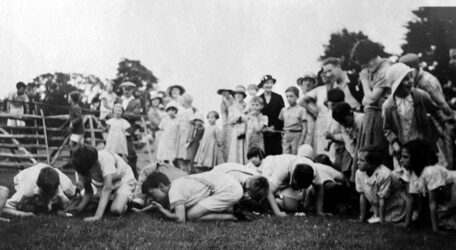
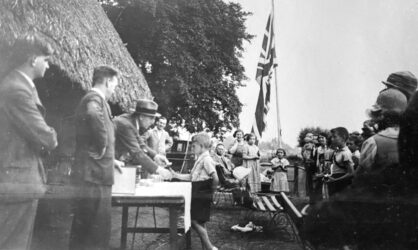
The school was later to become the Faringdon Church of England School taking in boys from 11 to 14 years of age, and finally closed down in 1936. It became used by Faringdon Youth Club, run by Russell Spinnage and in 1983 it was a warehouse for Tucker’s Nurseries, which was down the road. By 1994 it had been renovated into two private houses.
London Road
1833-1943?. The Female School of Industry/Industrial School for Girls, 125 girls. It became Faringdon Church of England Girls’ School then as part of Faringdon Girls’ Council School in 1927.
The school was erected in 1833 in London Road for 125 girls, 7 years after the National School for Boys in Stanford Road was opened. Mrs Shirley was headmistress from the late 1800’s until 1905 and then Miss Shilleto until the late 1920’s. The school became part of Faringdon Girls’ Council School in 1927. At the outbreak of WWII the building was used as a Drill Hall. It is now Chester House (private) #87 London Street, occupied by Dr. Humphries and his family.
Marlborough Street
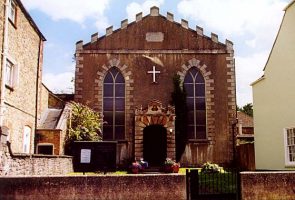 1843-1872. The British School, mixed, ages 7-14. It moved to Lechlade Road in 1872 (now the Infants School). British Schools were charitable schools that were non-denominational.
1843-1872. The British School, mixed, ages 7-14. It moved to Lechlade Road in 1872 (now the Infants School). British Schools were charitable schools that were non-denominational.
In 1843 a School House was built behind the Meeting House of the Congregational Church in Marlborough Street, now the Roman Catholic Church. The school was known as the British School. The pupils paid 2d per week unless there was more than one child of the family and then each paid 1½d. The aim of the school was to give the children a useful education. By 1896 this building was being used as a Sunday School with an Infant School attached to it on the west side. The school was still being used during the day to take the overflow from the primary school in Lechlade Road in the 1950s and 60s.
Lechlade Road / Canada Lane
1872. The British School, mixed, ages 7-14, moved here from Marlborough Street. The building became Faringdon Primary School in 1925, then finally Faringdon Infant School in 1964 when the junior pupils were moved out temporarily to Southampton Street. The school was closed down permanently at the end of October 2022.
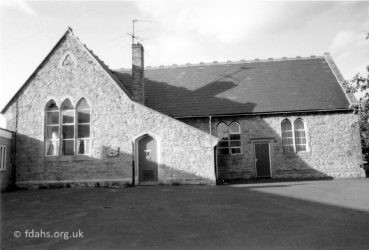
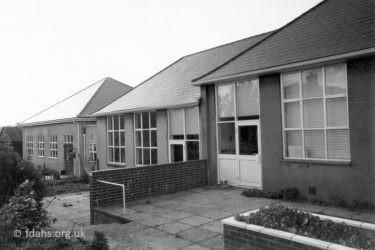
The building was erected for the British School in 1872 for 177 boys and girls and was paid for by voluntary subscription. The building is labelled on a map from 1876. Newer buildings have since been added during the 1950s down to the left along Canada Lane.
In the 1890’s there were extra classrooms in Station Road where the Fire Station is now (opened 1961). The building was later sold to a corn merchant and then became a Co-operative Hall. This hall and the old school behind the Methodist Church were still being used during the day to take the overflow from the primary school in the 1950s and 60s.
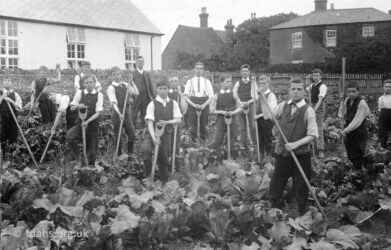 c1910. Henry Proctor (age 56?), headmaster of the British School in Lechlade Road, instructing his pupils in the art of gardening.
c1910. Henry Proctor (age 56?), headmaster of the British School in Lechlade Road, instructing his pupils in the art of gardening.
Mr & Mrs Proctor were the Headmaster and Headmistress at the school when they came to Faringdon from Liverpool in 1898. They had six children and as the pay was so poor they had to do extra teaching at night school. These dreadful conditions inspired them to become two of the Founder Members of National Union of Teachers. As the Government Grant to schools depended on the number of pupils attending Mr & Mrs Proctor had to arrange various events such as Christmas Concerts, Maypole Dancing, Country Dancing, Boy Scouts Camps, Girl Guides and all sorts of outside activities in order to attract more pupils. Mr Henry Proctor was in charge of First Aid for the district and he trained many of the nurses who went to France in World War I including Miss Taylor who later became Matron of the Faringdon Cottage Hospital. He was also specially qualified in Science and Archaeology and this was included in the school syllabus. Many of the boys, having left school, returned with specimens from various parts of the world and he had an extensive museum at the school.
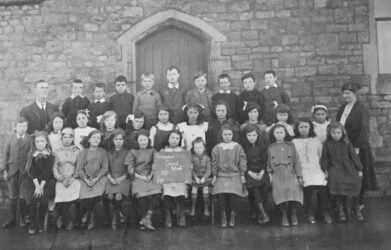 1920. The school is now calling itself Faringdon Council School here in 1920 (at the same time as the Council School in Southampton Street). This was before it became known as Faringdon Primary School in 1925. Henry Proctor, headmaster at the back left. In the velvet dress on the far left is Hilda Hunt. At this time Hilda’s mother Ruth owned a small sweet shop back down the road, attached to No.3 where they lived. In 1948 Hilda Llott, as she became took over the shop from her mother. Photo with thanks from Hilda‘s daughter Sally.
1920. The school is now calling itself Faringdon Council School here in 1920 (at the same time as the Council School in Southampton Street). This was before it became known as Faringdon Primary School in 1925. Henry Proctor, headmaster at the back left. In the velvet dress on the far left is Hilda Hunt. At this time Hilda’s mother Ruth owned a small sweet shop back down the road, attached to No.3 where they lived. In 1948 Hilda Llott, as she became took over the shop from her mother. Photo with thanks from Hilda‘s daughter Sally.
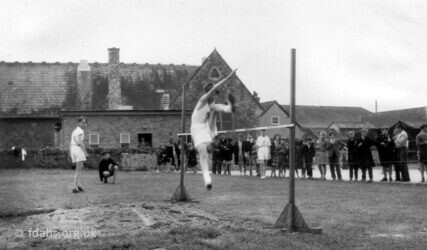 1959. Semi-finals North Berks Sports Junior Schools (Faringdon Area). Alan Blyth from Longcot walking away looking back, Brian McCabe waiting to jump, Bill Law clearing the Bar, and it might be John Hedgecock kneeling waiting to put the bar back. The school kitchen is in the background. Behind the high jump is now the school car park accessed from the Lechlade Road.
1959. Semi-finals North Berks Sports Junior Schools (Faringdon Area). Alan Blyth from Longcot walking away looking back, Brian McCabe waiting to jump, Bill Law clearing the Bar, and it might be John Hedgecock kneeling waiting to put the bar back. The school kitchen is in the background. Behind the high jump is now the school car park accessed from the Lechlade Road.
Southampton Street
1920s-1937. Faringdon Council School. There was also a separate Infant School with a separate building on the right but it moved to the Lechlade Road in 1925 and a main hall was built to join the two sections.
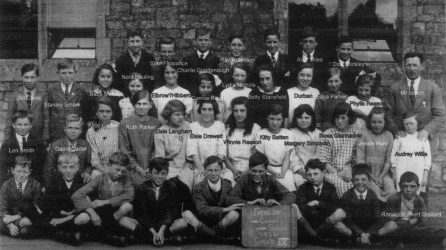
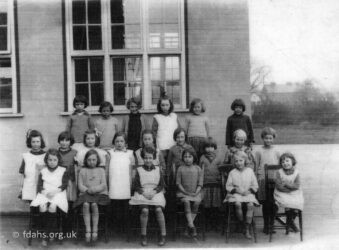
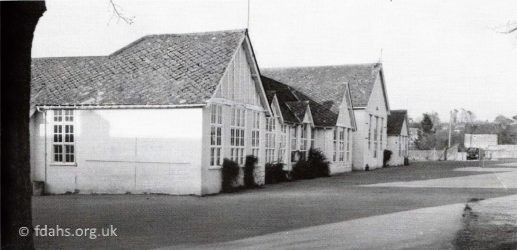 In 1941, the school became known as the Faringdon Senior School. In 1944-64 it became Faringdon Secondary Modern School (mixed) before moving in 1964 to the newly built Tollington School in Fernham Road. The school then became Faringdon Junior School (moved from Lechlade Road) in 1964-86 (then it moved to The Elms).
In 1941, the school became known as the Faringdon Senior School. In 1944-64 it became Faringdon Secondary Modern School (mixed) before moving in 1964 to the newly built Tollington School in Fernham Road. The school then became Faringdon Junior School (moved from Lechlade Road) in 1964-86 (then it moved to The Elms).
In the late 50s and early 60s the school intake grew so large that they had to make use of the old and dilapidated WW2 prisoner-of-war huts that were still there about 100 yards away in the fields at the end of the road. They were reported to be bitterly cold in winter, even with the ‘tortoise heaters’ that were provided. They were known colloquially by their occupants as “The ‘Uts”. They were reached along the lane by the cricket field, which in winter often flowed with rainwater, inevitably known as “The River ‘Ut”. In December 1960, after a particularly wet period, the school magazine reported that “The ‘River Utt’ has at many times been in full spate and on one occasion made the way to the hut classrooms impassable”.
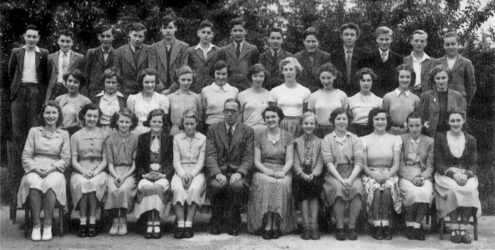 Form IVa, taken in 1951. Starting at the back and reading left to right, they are: D. Obee, Graham Harvey, Clifford Vaisey. David Miles, J. Gaule, D. Freeth, David Smallbone, C. Elbrow, Henry Lovegrove, B. Day, Vic Fisher, P. Jones, B. Tilling. Middle row: Pat Bowl, V. Keany, Peggy GoodalL Pam Harris, Lorna Wootton, M. Church, Sally Wozencroft, Pat Yoxall, Valeric Biltcliffe, Diana Greenhill, Pearl De Bank. Front row: June Page, Ros Cox, P. Whitehorn, J. Knight, Ann Wyatt, Headmaster Mr A.H. Willes, form teacher Mrs Firman, Rosalee Tipler, E. Prior, Shirley Durham, M. Nash, P. Partridge.5
Form IVa, taken in 1951. Starting at the back and reading left to right, they are: D. Obee, Graham Harvey, Clifford Vaisey. David Miles, J. Gaule, D. Freeth, David Smallbone, C. Elbrow, Henry Lovegrove, B. Day, Vic Fisher, P. Jones, B. Tilling. Middle row: Pat Bowl, V. Keany, Peggy GoodalL Pam Harris, Lorna Wootton, M. Church, Sally Wozencroft, Pat Yoxall, Valeric Biltcliffe, Diana Greenhill, Pearl De Bank. Front row: June Page, Ros Cox, P. Whitehorn, J. Knight, Ann Wyatt, Headmaster Mr A.H. Willes, form teacher Mrs Firman, Rosalee Tipler, E. Prior, Shirley Durham, M. Nash, P. Partridge.5
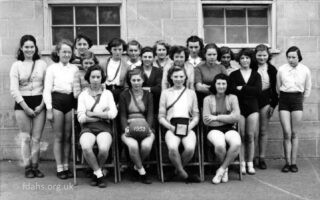
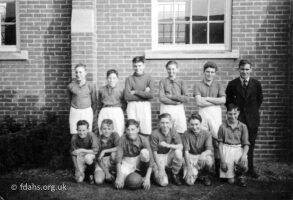
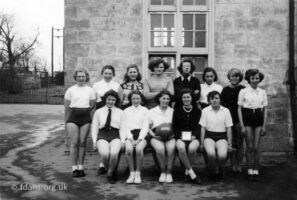
Some sports teams from the 1950s.
1986. All the school buildings were demolished and the site cleared to build the Willes Close housing estate. The close was named after the headmaster, who was the rather fearsome Arnold Willes.
Gloucester Street – The Elms
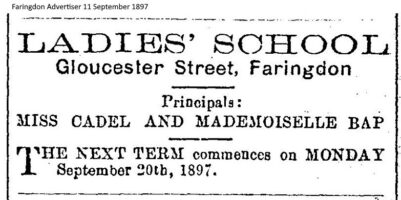 1895. Ladies’ School. The Elms was first a private house built early to mid 1700’s, before becoming the Ladies’ School in 1895. It was a fee paying school for girls age 9 and upwards and an entrance exam was required. Miss Cadel & Mademoiselle Bap were joint principals, followed in 1907 by Mrs G.E. Bye, then Mrs Bye & Miss Bye by 1916.
1895. Ladies’ School. The Elms was first a private house built early to mid 1700’s, before becoming the Ladies’ School in 1895. It was a fee paying school for girls age 9 and upwards and an entrance exam was required. Miss Cadel & Mademoiselle Bap were joint principals, followed in 1907 by Mrs G.E. Bye, then Mrs Bye & Miss Bye by 1916.
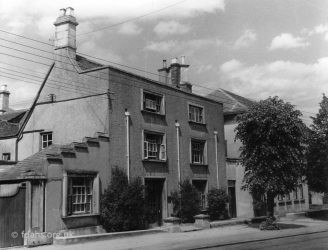 1920-1944. The Faringdon County School for Girls was opened to serve the north-west of the County (then Berkshire), but as the population of the area was small and scattered this was regarded as an experiment. There was accommodation for between 60 and 70 girls and a residence for the headmistress. The school opened with 18 pupils. There was a hard tennis court and also arrangements for hockey, cricket and swimming. There was a covered recreation room which was used for dinners, drill and indoor games. Arrangements were made for a bus service from Wantage with picking points en route. Subjects to be covered were Scripture, English Language, English Literature, History, Geography, Latin, French, Maths, Science, Drawing, Class Singing, P.E, Cookery, and Needlework. Pupils to be admitted from the age of 10 years and continue up to 18 years. The school prepared pupils for the Oxford School Certificate Exams and the Oxford Higher School Certificate Exam.
1920-1944. The Faringdon County School for Girls was opened to serve the north-west of the County (then Berkshire), but as the population of the area was small and scattered this was regarded as an experiment. There was accommodation for between 60 and 70 girls and a residence for the headmistress. The school opened with 18 pupils. There was a hard tennis court and also arrangements for hockey, cricket and swimming. There was a covered recreation room which was used for dinners, drill and indoor games. Arrangements were made for a bus service from Wantage with picking points en route. Subjects to be covered were Scripture, English Language, English Literature, History, Geography, Latin, French, Maths, Science, Drawing, Class Singing, P.E, Cookery, and Needlework. Pupils to be admitted from the age of 10 years and continue up to 18 years. The school prepared pupils for the Oxford School Certificate Exams and the Oxford Higher School Certificate Exam.
The building known as The Elms was owned by Lord Berners and leased to the county council. The lease was coming towards the end in 1931 so the site was purchased for £2,250. During 1932 new buildings were erected due to the rapid increase of pupils. In 1934 the council bought Knighton Close containing just over 3 acres, from Lord Berners at a price of £500. This was to be used for a playing field. By 1938 the numbers had increased to 100 girls so again the school required new buildings. By 1941 this had increased to 205 girls, which included 24 evacuees.
In 1931, at the annual prize-giving of the Faringdon County School for Girls, Miss Moore, the Head Mistress reported that the number of girls in the school was now seventy-four, drawn from a very wide area from Kingston Bagpuize to Highworth and from West Hendred to Clanfield. She commented favourably upon the Oxford School Certificate results, the general level of work in the school, the games activities, and the Old Girls’ successes. The health of the school had been good throughout the year. There were, however two serious handicaps to girls’ progress, a late entry, after the age of eleven years, into the school, and frequent short absences. Mr Walker the Chairman of the Berkshire Education Sub-Committee, who had come to present the prizes, had this to say about the number of “things” taught in a modern school, he said that the “things” themselves did not matter primarily, for they were merely to be used as aids for acquiring the qualities of character which was so vital to good living. He had grappled with the squaring of the hypotenuse in his school life, and although he had never met the creature since, the qualities of logical thinking and clear expression were helping him still today. Pulling flowers to bits in a botany lesson was not an end in itself, but the habit of observation acquired was of perpetual value in life. The alternate silence and laughter with which Mr Walker’s speech was received, showed how thoroughly he understood his audience.
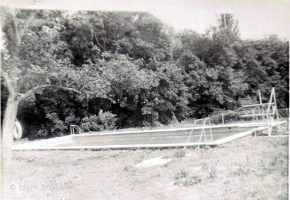 1944-74. The Elms School became Faringdon County Grammar School for Girls. To attend the school girls had to pass the 11 plus exams. Girls from the villages had to travel by bus. Grammar school boys were bussed out to King Alfred’s in Wantage. Girls attended Biology, Geography, Maths and Technology courses at various places. Theatre parties went to Oxford and Stratford and they undertook various visits to universities and colleges.The girls had to board coaches to take them to Buscot Park to use the outdoor swimming pool there until an outdoor pool was built in the school grounds around 1958.
1944-74. The Elms School became Faringdon County Grammar School for Girls. To attend the school girls had to pass the 11 plus exams. Girls from the villages had to travel by bus. Grammar school boys were bussed out to King Alfred’s in Wantage. Girls attended Biology, Geography, Maths and Technology courses at various places. Theatre parties went to Oxford and Stratford and they undertook various visits to universities and colleges.The girls had to board coaches to take them to Buscot Park to use the outdoor swimming pool there until an outdoor pool was built in the school grounds around 1958.
Some photos taken during the 1950s:
The cooking room shown in the photos above is now the town library.
1974. The Girls’ Grammar amalgamated with the Tollington School in Fernham Road to form Faringdon Comprehensive School. The buildings were used for the 6th form pupils. Slight adjustments had to be made to the Elms site to accommodate the boys.
1985. All pupils were moved to the comprehensive school on Fernham Road.
1986. The Elms finally became Faringdon Junior School, when the junior school in Southampton Street was demolished. The two buildings fronting on the street became private flats and the town library. The junior school is in the newer buildings behind these.
2022. Following the final closure of the infant school on the Lechlade Road, this school was renamed The Elms Primary School for infants and juniors.
Read more … notes from a talk on The Elms by Rosemary Church with more information about the building and the school: The Elms or full document here Elms Talk (pdf)
Fernham Road
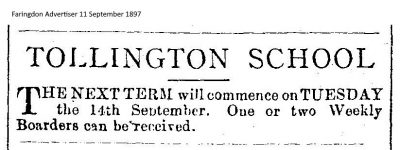 1895. Tollington House School, later in 1897 calling itself just Tollington School was advertised in the Faringdon Advertiser. The Principal was E.H.Griggs and as it took in boarders it was probably a private fee-paying school. Tollington House is at the top of Fernham Road on the corner of where the new Tollington Court housing estate is today. The new state school built on the opposite side of the road in 1964 took the same name for a while.
1895. Tollington House School, later in 1897 calling itself just Tollington School was advertised in the Faringdon Advertiser. The Principal was E.H.Griggs and as it took in boarders it was probably a private fee-paying school. Tollington House is at the top of Fernham Road on the corner of where the new Tollington Court housing estate is today. The new state school built on the opposite side of the road in 1964 took the same name for a while.
1964. Tollington Secondary Modern School (11-16 mixed), Fernham Road, off Coxwell Road. It became Faringdon Comprehensive School (11-18 mixed) in 1974. In 2001 it was renamed Faringdon Community College and in 2012 it became part of the Faringdon Academy of Schools along with Faringdon Infant School and Faringdon Junior School.
The school was built in 1962/63 on a green-field site opposite Tollington House, which was right out of town at that time. Houses had been built all along the main roads but it was well before any of the large housing estates had been built. All was practically clear to Park Road, the railway line, and over Stanford Road to Folly Hill (photo).
Folly View Primary School
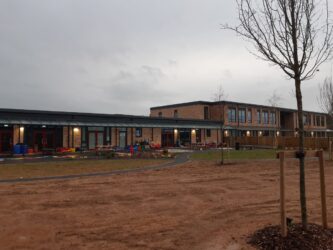 2022. A brand new school for infants and juniors opened after the Autumn half-term that year. It was built on Sands Hill above the new Oriel Gardens housing development. The site is on Preston Place, which is at the end of Proctor Way off Park Road. It was built to replace the old infant school on the corner of Lechlade Road and Canada Lane, which was closed down permanently, and to increase the primary education capacity for the rapidly expanding population of the town.
2022. A brand new school for infants and juniors opened after the Autumn half-term that year. It was built on Sands Hill above the new Oriel Gardens housing development. The site is on Preston Place, which is at the end of Proctor Way off Park Road. It was built to replace the old infant school on the corner of Lechlade Road and Canada Lane, which was closed down permanently, and to increase the primary education capacity for the rapidly expanding population of the town.
Church Farm House School
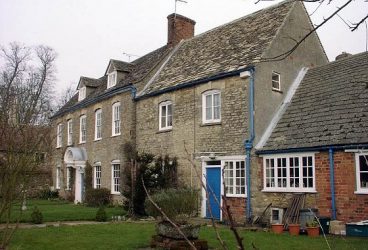 1938-52. #20 Church Street – Church Farmhouse and Church Farm Cottage are through the gate in the garden wall, almost opposite the turning into Radcot Road. Now a Grade II Listed Building, it was once used as a school for 7-13 year olds. Known as Church Farm House School it was run by a very strict Miss Downs and a very musical Miss Sims. It was part boarding and part day pupils. One ex-pupil says it was boys only but other ex-pupils say it was mixed.
1938-52. #20 Church Street – Church Farmhouse and Church Farm Cottage are through the gate in the garden wall, almost opposite the turning into Radcot Road. Now a Grade II Listed Building, it was once used as a school for 7-13 year olds. Known as Church Farm House School it was run by a very strict Miss Downs and a very musical Miss Sims. It was part boarding and part day pupils. One ex-pupil says it was boys only but other ex-pupils say it was mixed.
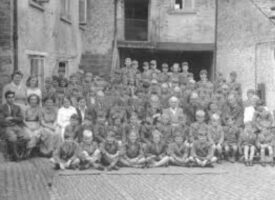
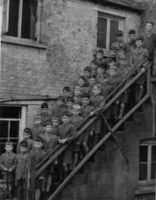 There were dormitories at Church Farm House but also at Romney House (19 Gloucester Street).
There were dormitories at Church Farm House but also at Romney House (19 Gloucester Street).
At Church Farm House the old stable was used as a classroom, chapel and song school and all pupils were given a good grounding in choral singing as the boys were sent at 13 to Cathedral Schools all over England. The girls were sent to Christ’s Hospital schools. One famous ex-pupil was Mark Santer who went to Marlborough College, and Queen’s College Cambridge and became Bishop of Birmingham. The field beyond Church Farm House was extensive enough for an orchard and a football pitch though some of it has now been built over. The school was divided into ‘Houses’ one of which was Shepard House named after the illustrator of Winnie the Pooh, E.H.Shepard. He used to write letters to his House and sign them by drawing a little piglet waving goodbye. Many of the memories are of an exceptional school. French and German were taught and there were plenty of books introduced including Guy de Maupassant, Sir Walter Scott, John Buchan, Wilkie Collins and H G Wells. An all-round education was given, and they left with good manners and speech. Alan Hitchcock (later a town councillor) remembered the staff as many special and extraordinary people.
The school was in action during the war years and that might account for the meagre rations that are described: fried bread and lumpy salty porridge for breakfast and chocolate bars and syrup of figs once a week, leading to the raiding of the fruit bushes in the orchard for puddings. There were horsehair mattresses and thin blankets.
Ferndale School
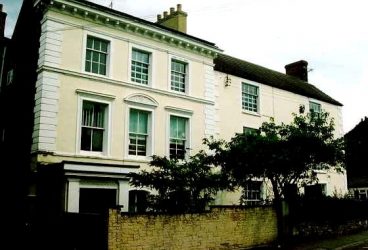 1952-2016. Ferndale independent private school was opened in 1952 by Nancy Reeves (1920-2006) at the back of Dunraven House in London Street, which belonged to Mrs Ruth White. The school catered for children between the ages of four and eleven. The six pupils who went to the first session were Michael and Christopher Day, Anna White, Peter Niker, Brenda Blissett, and Carole Hazell. In 1953 the school was expanding and so moved to Chieveley House in Gloucester Street. This was followed in 1956 to the final move to Brockendon House in Bromsgrove (photo). Throughout the 1960’s buildings were added and altered and by the 21st anniversary there were 132 children on roll.
1952-2016. Ferndale independent private school was opened in 1952 by Nancy Reeves (1920-2006) at the back of Dunraven House in London Street, which belonged to Mrs Ruth White. The school catered for children between the ages of four and eleven. The six pupils who went to the first session were Michael and Christopher Day, Anna White, Peter Niker, Brenda Blissett, and Carole Hazell. In 1953 the school was expanding and so moved to Chieveley House in Gloucester Street. This was followed in 1956 to the final move to Brockendon House in Bromsgrove (photo). Throughout the 1960’s buildings were added and altered and by the 21st anniversary there were 132 children on roll.
1964. Thank you Annie Varney for this picture of Ferndale School. Diana Maslin, an ex-pupil says that, “The photo was taken in front of the old main school building. There were steps down from the porch in the right of the photo into a hallway type of place with wash basins I think. Then from there you turned left & went through a corridor which had girls loos at the bottom of the stairs & the entrance to Mrs Reeves private rooms. There were a couple of classrooms on different levels up the stairs & her office was at the top of the stairs. She had a red & green light outside the door to show whether you could knock or not. No one in their right mind went to her office voluntarily!!!”
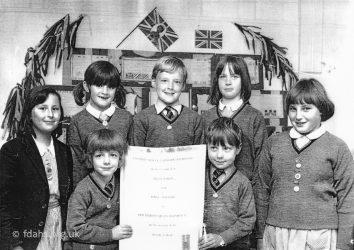 1977. The school celebrated its 25th anniversary in the same year as the Queen celebrated her silver jubilee. The children of the school sent special greetings to the Queen on a decorative scroll signed by all the pupils and had a special letter of thanks in return (photo). Ferndale School took part in the usual school activities such as sports and concerts, but also took a special interest in the Victoria Home for Crippled Children at Bournemouth and raised money annually for this good cause. The children used to send a card each week to the home from each form in the school. They also had a special interest in raising money for Dr. Barnado’s Charity.
1977. The school celebrated its 25th anniversary in the same year as the Queen celebrated her silver jubilee. The children of the school sent special greetings to the Queen on a decorative scroll signed by all the pupils and had a special letter of thanks in return (photo). Ferndale School took part in the usual school activities such as sports and concerts, but also took a special interest in the Victoria Home for Crippled Children at Bournemouth and raised money annually for this good cause. The children used to send a card each week to the home from each form in the school. They also had a special interest in raising money for Dr. Barnado’s Charity.
Nancy Reeves retired from the school in 1979 and a Mr & Mrs Collinge took over as joint principals. The school was sold to a company at this time or at some point later and continued for many more years. It was finally closed after being put into administration on 22nd July 2016 due to financial difficulties.
Nancy Reeves – Star of Stage and School (Faringdon Folly March 1992) – bill-nancy-reeves-ff1992.pdf
Memories of Schooldays in the 1930’s
“Discipline was tight and punishments were there for the least breach of the rules. Minor punishments were being kept in at playtimes and after school hours. Also writing out lines I must not do this, that and the other. Stiffer penalties was being told to go and stand outside the headmasters door, you’d stand there for an hour or more, prolonging the agony knowing what the outcome was going to be, and that was a caning across the palms of the hands. The worse one was a public flogging that when the whole school mustered in the hall and the offender taken on the stage, told to bend over and receive six of the best. The girls punishment was having to clench their fists and having their knuckles rapped with a wooden ruler – very painful. We never had any homework to do in those days.”
“We had to use pen and ink, the ink being in a small ink-well in a round hole in the desk. You had to make sure you didn’t dip the pen in too deep, or else if you did and your hand shook, or you coughed then a big blob of ink dropped off leaving a ink-blot in your book, and when you started to write all the a b e g and p’s centres filled in creating an unholy mess which I learnt to my cost. You see in those days the school supplied everything, books, pens etc. So the time came when my first writing book became full, so the drill was you went to the head masters room for a new one taking the full one with you. So off I went and knocked on Mr T’s door, he barked come in, in I went, what do you want he roared, a new writing book please sir. He took the old one off me, looked at it, and that’s when he went berserk, completely off his rocker, he grabbed his cane, danced around the room slashing the air making it whistle, he then went to his desk and whacked it half a dozen times, then he turned to me and said very quietly, you see what I’m doing to this desk, I said yes sir, next time you bring a book to me in this state it will not be the desk I’ll be hitting, you know why, no sir and then with a roar like a clap of thunder coming out of a drain pipe he said because your backside will be on the desk and my cane will be descending upon it, now get out. From that moment in time my writing and neatness improved a hundredfold, there was no way I was going to call his bluff.”
References:
- The Changing Faces of Faringdon and Surrounding Villages – Bk 2 p12-25 & Bk 3 p85. By Rosemary Church, Jim Brown, Millie Bryan and Beryl Newman. Robert Boyd Publications 2001 & 2003.
- The Faringdon Advertiser, 25th December 1931 p5 & 10th July 1936 p3.
- Document researched and written by Peter Gale entitled ‘Sudbury House, Faringdon – A Private School in the Early 19th-century, situated within the Bailey of a Medieval Castle’. Download PDF
- Document researched and written by Felicity Cormack entitled ‘Corners of Faringdon 1’ – Church Farm House School. Download PDF
- Faringdon Folly, June 1993, p11 – More of Your Salad Days by Jim Brown.
Researched by Ian Lee, February 2020.
